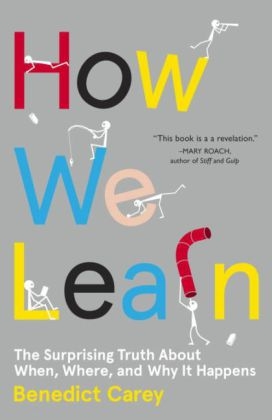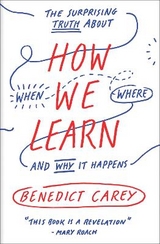
How We Learn
Penguin Random House (Verlag)
978-0-8129-9911-2 (ISBN)
- Titel erscheint in neuer Auflage
- Artikel merken
In the tradition of The Power of Habit and Thinking, Fast and Slow comes a practical, playful, and endlessly fascinating guide to what we really know about learning and memory today - and how we can apply it to our own lives.
From an early age, it is drilled into our heads: Restlessness, distraction, and ignorance are the enemies of success. We're told that learning is all self-discipline, that we must confine ourselves to designated study areas, turn off the music, and maintain a strict ritual if we want to ace that test, memorize that presentation, or nail that piano recital.
But what if almost everything we were told about learning is wrong? And what if there was a way to achieve more with less effort?
In How We Learn, award-winning science reporter Benedict Carey sifts through decades of education research and landmark studies to uncover the truth about how our brains absorb and retain information. What he discovers is that, from the moment we are born, we are all learning quickly, efficiently, and automatically; but in our zeal to systematize the process we have ignored valuable, naturally enjoyable learning tools like forgetting, sleeping, and daydreaming. Is a dedicated desk in a quiet room really the best way to study? Can altering your routine improve your recall? Are there times when distraction is good? Is repetition necessary? Carey's search for answers to these questions yields a wealth of strategies that make learning more a part of our everyday lives - and less of a chore.
By road testing many of the counterintuitive techniques described in this book, Carey shows how we can flex the neural muscles that make deep learning possible. Along the way he reveals why teachers should give final exams on the first day of class, why it's wise to interleave subjects and concepts when learning any new skill, and when it's smarter to stay up late prepping for that presentation than to rise early for one last cram session. And if this requires some suspension of disbelief, that's because the research defies what we've been told, throughout our lives, about how best to learn.
The brain is not like a muscle, at least not in any straightforward sense. It is something else altogether, sensitive to mood, to timing, to circadian rhythms, as well as to location and environment. It doesn't take orders well, to put it mildly. If the brain is a learning machine, then it is an eccentric one. In How We Learn, Benedict Carey shows us how to exploit its quirks to our advantage.
Advance praise for How We Learn
"This book is a revelation. I feel as if I've owned a brain for fifty-four years and only now discovered the operating manual. For two centuries, psychologists and neurologists have been quietly piecing together the mysteries of mind and memory as they relate to learning and knowing. Benedict Carey serves up their most fascinating, surprising, and valuable discoveries with clarity, wit, and heart. I wish I'd read this when I was seventeen." - Mary Roach, bestselling author of Stiff and Gulp
" How We Learn is as fun to read as it is important, and as much about how to live as it is about how to learn. Benedict Carey's skills as a writer, plus his willingness to mine his own history as a student, give the book a wonderful narrative quality that makes it all the more accessible - and all the more effective as a tutorial." - Robert A. Bjork, Distinguished Research Professor, Department of Psychology, University of California, Los Angeles
From the Hardcover edition.
Chapter One
The Story Maker
The Biology of Memory
The science of learning is, at bottom, a study of the mental muscle doing the work - the living brain - and how it manages the streaming sights, sounds, and scents of daily life. That it does so at all is miracle enough. That it does so routinely is beyond extraordinary.
Think of the waves of information rushing in every waking moment, the hiss of the kettle, the flicker of movement in the hall, the twinge of back pain, the tang of smoke. Then add the demands of a typical layer of multitasking - say, preparing a meal while monitoring a preschooler, periodically returning work emails, and picking up the phone to catch up with a friend.
Insane.
The machine that can do all that at once is more than merely complex. It's a cauldron of activity. It's churning like a kicked beehive.
Consider several numbers. The average human brain contains 100 billion neurons, the cells that make up its gray matter. Most of these cells link to thousands of other neurons, forming a universe of intertwining networks that communicate in a ceaseless, silent electrical storm with a storage capacity, in digital terms, of a million gigabytes. That's enough to hold three million TV shows. This biological machine hums along even when it's "at rest," staring blankly at the bird feeder or some island daydream, using about 90 percent of the energy it burns while doing a crossword puzzle. Parts of the brain are highly active during sleep, too.
The brain is a dark, mostly featureless planet, and it helps to have a map. A simple one will do, to start. The sketch below shows several areas that are central to learning: the entorhinal cortex, which acts as a kind of filter for incoming information; the hippocampus, where memory formation begins; and the neocortex, where conscious memories are stored once they're flagged as keepers.
This diagram is more than a snapshot. It hints at how the brain operates. The brain has modules, specialized components that divide the labor. The entorhinal cortex does one thing, and the hippocampus does another. The right hemisphere performs different functions from the left one. There are dedicated sensory areas, too, processing what you see, hear, and feel. Each does its own job and together they generate a coherent whole, a continually updating record of past, present, and possible future.
In a way, the brain's modules are like specialists in a movie production crew. The cinematographer is framing shots, zooming in tight, dropping back, stockpiling footage. The sound engineer is recording, fiddling with volume, filtering background noise. There are editors and writers, a graphics person, a prop stylist, a composer working to supply tone, feeling - the emotional content - as well as someone keeping the books, tracking invoices, the facts and figures. And there's a director, deciding which pieces go where, braiding all these elements together to tell a story that holds up. Not just any story, of course, but the one that best explains the "material" pouring through the senses. The brain interprets scenes in the instants after they happen, inserting judgments, meaning, and context on the fly. It also reconstructs them later on - what exactly did the boss mean by that comment? - scrutinizing the original footage to see how and where it fits into the larger movie.
It's a story of a life - our own private documentary - and the film "crew" serves as an animating metaphor for what's happening behind the scenes. How a memory forms. How it's retrieved. Why it seems to fade, change, or grow more lucid over time. And how we might manipulate each step, to make the details richer, more vivid, clearer.
Remember, the director of this documentary is not some film school graduate, or a Holly
| Zusatzinfo | w. diagrams |
|---|---|
| Sprache | englisch |
| Maße | 154 x 234 mm |
| Gewicht | 384 g |
| Themenwelt | Geisteswissenschaften ► Psychologie |
| Sozialwissenschaften ► Pädagogik ► Allgemeines / Lexika | |
| Schlagworte | Lernverhalten |
| ISBN-10 | 0-8129-9911-8 / 0812999118 |
| ISBN-13 | 978-0-8129-9911-2 / 9780812999112 |
| Zustand | Neuware |
| Haben Sie eine Frage zum Produkt? |
aus dem Bereich



